
- Usage in publication:
-
- Laupahoehoe volcanic series*
- Modifications:
-
- Named
- Dominant lithology:
-
- Volcanics
- AAPG geologic province:
-
- Hawaii
Summary:
Named for exposures at type locality at Laupahoehoe peninsula [point, 19 deg 59'48"N, 155 deg 14'34"W, Papaaloa 7.5' quad] on E side of Mauna Kea Volcano, Island of Hawaii, HI. Is typical andesite flow which has built lava delta. Many of lava tongues are only one or two flows in thickness. Probably nowhere does its exposed thickness exceed 100 ft. "However if a caldera formerly existed ... the series may reach a thickness of two or three thousand feet." Overlies with erosional unconformity Hamakua volcanic series at type locality. In places conformably overlies Hamakua volcanic series.
Source: GNU records (USGS DDS-6; Menlo GNULEX).
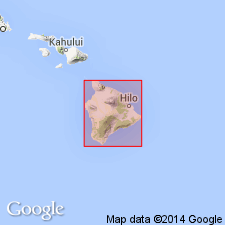
- Usage in publication:
-
- Laupahoehoe volcanic series*
- Modifications:
-
- Age modified
- AAPG geologic province:
-
- Hawaii
Summary:
Divided into lower member (consisting of andesine andesite and olivine basalt) and upper member (consisting of 6 small flows of andesite). Entire top of Mauna Kea is composed of Laupahoehoe volcanic series. On S side of volcano, unit overlaps Hamakua lavas and is interbedded with Kau volcanic series of Mauna Loa Volcano. Lower member is of Pleistocene age and is overlain by glacial moraine. Upper member overlies glacial moraine and is post-glacial in age, hence Recent.
Source: GNU records (USGS DDS-6; Menlo GNULEX).
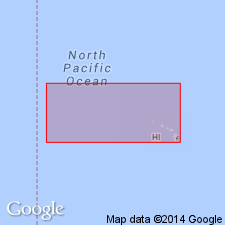
- Usage in publication:
-
- Laupahoehoe volcanic series*
- Modifications:
-
- Age modified
- AAPG geologic province:
-
- Hawaii
Summary:
Age assignment of Laupahoehoe volcanic series to Pleistocene and Recent(?) depends on relation to Pahala ash and glaciation.
Source: GNU records (USGS DDS-6; Menlo GNULEX).
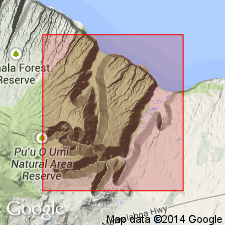
- Usage in publication:
-
- Laupahoehoe Volcanic Series*
- Modifications:
-
- Geochronologic dating
- AAPG geologic province:
-
- Hawaii
Summary:
K-Ar ages of 0.6 +/-0.3 Ma and 2.8 +/-0.1 Ma was obtained on whole rock and biotite, respectively, from single lava flow from Laupahoehoe Volcanic Series (Funkhauser and others, 1968), "but because of extraneous argon it is likely that both these ages are too old."
Source: GNU records (USGS DDS-6; Menlo GNULEX).
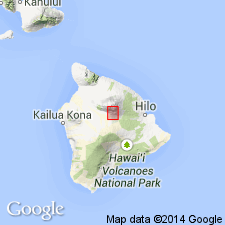
- Usage in publication:
-
- Laupahoehoe Group
- Modifications:
-
- Redescribed
- Revised
- AAPG geologic province:
-
- Hawaii
Summary:
Laupahoehoe Volcanic Series [Macdonald, 1945] changed to Laupahoehoe Group and subdivided on basis of sheets of glacial drift. Principal tephra layers and buried soils (ascending) are: Puu Hookomo tephra, Hookomo soil, Puu 8987 tephra, Puu Haiwahine tephra, Buried Cone tephra, Humuula soil, Puu Kole tephra, and Puu Loaloa-Puu Huikau tephra complex. Humuula soil separates youngest (post-glacial) layer from older layers. Youngest ash layer is inferred to be about 3600 years old (Woodstock and others, 1966).
Source: GNU records (USGS DDS-6; Menlo GNULEX).
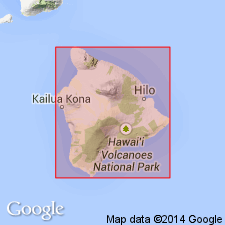
- Usage in publication:
-
- Laupahoehoe Group
- Modifications:
-
- Revised
- AAPG geologic province:
-
- Hawaii
Summary:
Divided into (ascending): Liloe, Waihu, Hanaipoe, Makanaka and Waikahalulu Formations based on four episodes of ice-cap glaciation designated from oldest to youngest: Pohakuloa, Waihu, early Makanaka, and late Makanaka. Makanaka Formation is further subdivided into lower member, Kemole Member, and upper member. Assigned to Pleistocene age with exception of Waikahalulu Formation which is Holocene age.
Source: GNU records (USGS DDS-6; Menlo GNULEX).
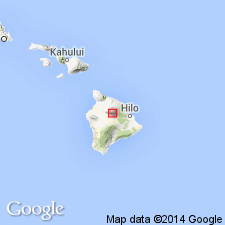
- Usage in publication:
-
- Laupahoehoe Group
- Modifications:
-
- Geochronologic dating
- AAPG geologic province:
-
- Hawaii
Summary:
K-Ar ages for samples from Liloe Formation are 188,000 +/-15,000 and 177,000 +/-20,000 yr B.P. Samples from Waihu Formation range from 136,000 +/-14,000 to 113,000 +/-15,000 yr B.P. K-Ar age for Hanaipoe Formation is 85,000 +/-13,000 yr B.P. For lower member of Makanaka Formation age is 54,900 +/-8,500 yr B.P. Kemole Member samples range from 37,200 +/-1,400 to 22,150 +/-250 yr B.P. Waikahalulu Formation has carbon-14 age range of 9080 +/-200 to 4500 yr B.P.
Source: GNU records (USGS DDS-6; Menlo GNULEX).
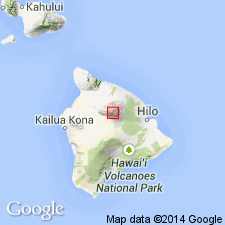
- Usage in publication:
-
- Laupahoehoe Group
- Modifications:
-
- Revised
- Geochronologic dating
- AAPG geologic province:
-
- Hawaii
Summary:
Divided into 3 formations: volcanic Waikahalulu Formation, and 2 glacial sedimentary units, the Waihu and Makanaka Formations. Names Liloe, Hanaipoe, and Kemole are herein abandoned as formal names of lithostratigraphic units and formally applied to chronostratigraphic units --Liloen, Hanaipoean, and Kemolean Stages. K-Ar and carbon-14 ages range from 174,400 +/-26,500 through 4400 +/-110 yr B.P.
Source: GNU records (USGS DDS-6; Menlo GNULEX).

- Usage in publication:
-
- Laupahoehoe Volcanics*
- Modifications:
-
- Revised
- AAPG geologic province:
-
- Hawaii
Summary:
Because use of Laupahoehoe as unit of group rank is not consistent with approach used here for rest of volcanoes of Hawaiian Islands, this unit is reduced to formation rank and renamed Laupahoehoe Volcanics. Is subdivided into three members; Waikahalulu Volcanic Member which interfingers with (ascending): Waihu Glacial and Makanaka Glacial Members. Reference localities are in Waikahalulu and Pohakuloa Gulches. Age is Holocene and Pleistocene.
Source: GNU records (USGS DDS-6; Menlo GNULEX).
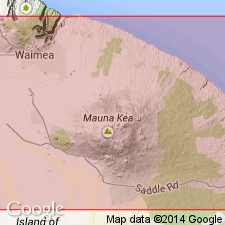
- Usage in publication:
-
- Laupahoehoe Volcanics*
- Modifications:
-
- Revised
- AAPG geologic province:
-
- Hawaii
Summary:
Unit is stratigraphically restricted to exclude Waihu Glacial Member (reassigned to Hamakua Volcanics) and basaltic rocks of now-abandoned Waikahalulu Volcanic Member (reassigned to Liloe Spring Volcanic Member (new) of Hamakua Volcanics). Age is Pleistocene and Holocene.
Source: GNU records (USGS DDS-6; Menlo GNULEX).
For more information, please contact Nancy Stamm, Geologic Names Committee Secretary.
Asterisk (*) indicates published by U.S. Geological Survey authors.
"No current usage" (†) implies that a name has been abandoned or has fallen into disuse. Former usage and, if known, replacement name given in parentheses ( ).
Slash (/) indicates name conflicts with nomenclatural guidelines (CSN, 1933; ACSN, 1961, 1970; NACSN, 1983, 2005, 2021). May be explained within brackets ([ ]).

